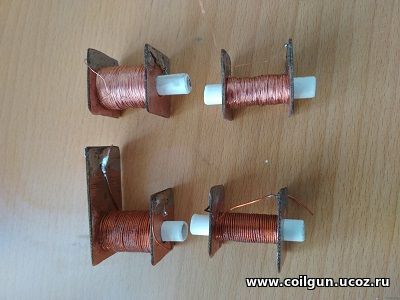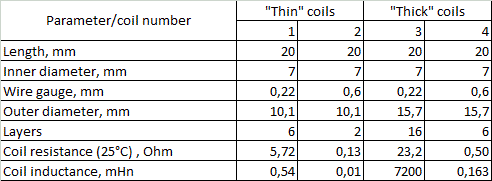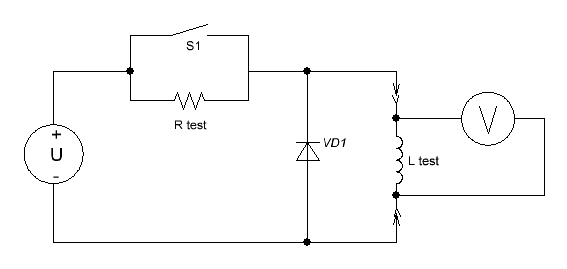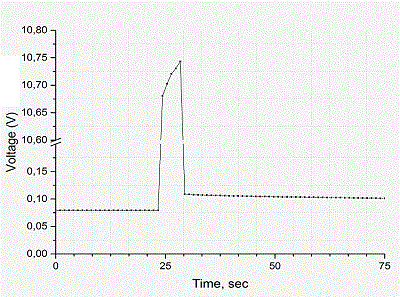
Heat transfer dynamics in the winings of coilguns
_Eugen_, Sun Nov 03 2019, 09:48AMIn my latest calculations considering projectile speed limitations in reluctance accelerators of different constructions, I concluded that one of the main such factors, especially for small-caliber coilguns, is the ohmic heat of the accelerating windings. This problem was not of a major role while portative accelerators had low energies, but it becomes significant as more powerful and high fire-rate constructions have apeared.
In this article an experiment is described which was arranged to investigate heating and cooling of coils in conditions inherent to the typical portative coilgun launchers.The detailed description of the experiment is here as usual, below is brief summary and results.
In this article an experiment is described which was arranged to investigate heating and cooling of coils in conditions inherent to the typical portative coilgun launchers.The detailed description of the experiment is here as usual, below is brief summary and results.
Re: Heat transfer dynamics in the winings of coilguns
_Eugen_, Sun Nov 03 2019, 09:56AM
Four coils were manufactured for the experiment, their paramters and photos are below.

The samples. All the coils wound on plastic frames of the same diameter. Limiters are of textolite.

The coils molded with epoxy.

Parameters of the samples.
_Eugen_, Sun Nov 03 2019, 09:56AM
Four coils were manufactured for the experiment, their paramters and photos are below.

The samples. All the coils wound on plastic frames of the same diameter. Limiters are of textolite.

The coils molded with epoxy.

Parameters of the samples.
Re: Heat transfer dynamics in the winings of coilguns
_Eugen_, Sun Nov 03 2019, 10:00AM



_Eugen_, Sun Nov 03 2019, 10:00AM
A short term (3..6 seconds) commutation to a power source through a simple toggle switch was used to heat the coils to an appropriate temperature. The temperature was controlled by measuring the DC resistance of the winding by forcing a test current of some fixed (few miilamperes) value. Power resistors were connected in parralel to the switch to ensure those current from the "heating" power source when the switch is open. A reverse biased diode was inserted in anti-parallel to the investigated coil to prevent an inductive peak to damage the toggle.
Below are schematic diagram of testing, a workplace for the experiment and example of the mesured signal.
Below are schematic diagram of testing, a workplace for the experiment and example of the mesured signal.



Re: Heat transfer dynamics in the winings of coilguns
_Eugen_, Sun Nov 03 2019, 10:04AM
_Eugen_, Sun Nov 03 2019, 10:04AM
What can we see on the latter picture? Before the switch is closed, the signal is constant and equals to U = I·R where I is testing current, R is winding resistance at room temperature. After a short period of exciting voltage fed, the toggle is off again and the coil starts to cool down, then its voltage drop can be written as I·(1 + α·∆T)·R, where ∆T is temperature difference between the initial temperature of the coil and the room one, and α is temperature coefficient of resistance for copper, which is known to be about 0.0043 1/ºC.
Thermodynamic equations above can be used to determine the temperature of the coil, and waveforms - to calculate a heat tranfer rate (J/sec).
Thermodynamic equations above can be used to determine the temperature of the coil, and waveforms - to calculate a heat tranfer rate (J/sec).
Re: Heat transfer dynamics in the winings of coilguns
_Eugen_, Sun Nov 03 2019, 10:09AM
_Eugen_, Sun Nov 03 2019, 10:09AM
Conclusions
1) Cooling time constants for the investigated coils are 5..12 sec for the highest temperatures reached in the experiment. As a coil cools down substantially during ~3Ï„, we may state that for a powerful coilgun of about 7 mm caliber working closely to a thermal limit (i.e. with coil(s) heated nearly up to the damage point), it is inexpedient to maintain capacitor recharging time of less than ~30 sec.
2) As expected, "thin" coils cool down quicker that "thick" ones, but the rate of cooling is not proportional to the coil's heat capacity (mass). On the contrary, the rate correlates well with the ratio of heat capacity to the area of the coil. Basically, it can be said that "thick" coils cool down twice slower than "thin" ones.
3) Epoxy molding has an ambivalent effect on the heat transfer. "Free" approximation of the initial region of the coooling curve yields some deceleration of the process, but there's an opposite result in all other cases. Anyway, the cooling rate changes no more than doubly, i.e. without any dramatical shift.
4) Heat transfer rate is in range of 4..20 J/sec for the coils under experiment with temperatures about 100°C. Having got these values, it is possible to evaluate a firing rate of a specific coilgun provided an energy deposition for its coils is known. For example, EM-3 "Electric bow" coilgun with its windings close to № 3 or 4 by parameters, would be able to make 1 shot per 7 sec while keeping the temperature of its coils about 100°C.
2) As expected, "thin" coils cool down quicker that "thick" ones, but the rate of cooling is not proportional to the coil's heat capacity (mass). On the contrary, the rate correlates well with the ratio of heat capacity to the area of the coil. Basically, it can be said that "thick" coils cool down twice slower than "thin" ones.
3) Epoxy molding has an ambivalent effect on the heat transfer. "Free" approximation of the initial region of the coooling curve yields some deceleration of the process, but there's an opposite result in all other cases. Anyway, the cooling rate changes no more than doubly, i.e. without any dramatical shift.
4) Heat transfer rate is in range of 4..20 J/sec for the coils under experiment with temperatures about 100°C. Having got these values, it is possible to evaluate a firing rate of a specific coilgun provided an energy deposition for its coils is known. For example, EM-3 "Electric bow" coilgun with its windings close to № 3 or 4 by parameters, would be able to make 1 shot per 7 sec while keeping the temperature of its coils about 100°C.
Print this page